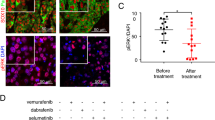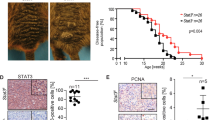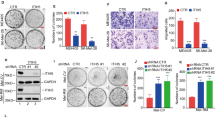Abstract
Transforming growth factor-β (TGF-β) has dual and paradoxical functions as a tumor suppressor and promoter of tumor progression and metastasis. TGF-β-mediated growth inhibition is gradually lost during melanoma tumor progression, but there are no measurable defects at the receptor level. Furthermore, melanoma cells release high levels of TGF-β to the microenvironment, which upon activation induces matrix deposition, angiogenesis, survival, and transition to more aggressive phenotypes. The SKI and SnoN protein family associate with and repress the activity of Smad2, Smad3, and Smad4, three members of the TGF-β signaling pathway. SKI also facilitates cell-cycle progression by targeting the RB pathway by at least two ways: it directly associates with RB and represses its activity when expressed at high levels, and indirectly, it represses Smad-mediated induction of p21Waf-1. This results in increased CDK2 activity, RB phosphorylation, and inactivation. Therefore, high levels of SKI result in lesions to the RB pathway in a manner similar to p16INK4a loss. SKI mRNA and protein levels dramatically increase during human melanoma tumor progression. In addition, the SKI protein shifts from nuclear localization in intraepidermal melanoma cells to nuclear and cytoplasmic in invasive and metastatic melanomas. Here, I discuss the basis for repression of intracellular TGF-β signaling by SKI, some additional activities of this protein, and propose that by disrupting multiple tumor suppressor pathways, SKI functions as a melanoma oncogene.
This is a preview of subscription content, access via your institution
Access options
Subscribe to this journal
Receive 50 print issues and online access
$259.00 per year
only $5.18 per issue
Buy this article
- Purchase on Springer Link
- Instant access to full article PDF
Prices may be subject to local taxes which are calculated during checkout



Similar content being viewed by others
References
Akhurst RJ and Derynck R . (2001). Trends Cell Biol., 11, S44–S51.
Akiyoshi S, Inoue H, Hanai J, Kusanagi K, Nemoto N, Miyazono K and Kawabata M . (1999). J. Biol. Chem., 274, 35269–35277.
Amaravadi LS, Neff AW, Sleeman JP and Smith RC . (1997). Dev. Biol., 192, 392–404.
Attisano L and Tuen Lee-Hoeflich S . (2001). Genome Biol., 2, REVIEWS3010.
Bardeesy N, Bastian BC, Hezel A, Pinkel D, DePinho RA and Chin L . (2001). Mol. Cell Biol., 21, 2144–2153.
Barkas A . (1986). Ph. D. dissertation (New York University, New York).
Baylin SB, Esteller M, Rountree MR, Bachman KE, Schuebel K and Herman JG . (2001). Hum. Mol. Genet., 10, 687–692.
Berk M, Desai SY, Heyman HC and Colmenares C . (1997). Genes Dev., 11, 2029–2039.
Berking C, Takemoto R, Schaider H, Showe L, Satyamoorthy K, Robbins P and Herlyn M . (2001). Cancer Res., 61, 8306–8316.
Bonni S, Wang HR, Causing CG, Kavsak P, Stroschein SL, Luo K and Wrana JL . (2001). Nat. Cell Biol., 3, 587–595.
Boyer PL, Colmenares C, Stavnezer E and Hughes SH . (1993). Oncogene, 8, 457–466.
Cohen SB, Zheng G, Heyman HC and Stavnezer E . (1999). Nucleic Acids Res., 27, 1006–1014.
Colmenares C, Heilstedt HA, Shaffer LG, Schwartz S, Berk M, Murray JC and Stavnezer E . (2001). Nat. Genet., 30, 106–109.
Colmenares C, Sutrave P, Hughes SH and Stavnezer E . (1991). J. Virol., 65, 4929–4935.
Dahl R, Kieslinger M, Beug H and Hayman MJ . (1998a). Proc. Natl. Acad. Sci. USA, 95, 11187–11192.
Dahl R, Wani B and Hayman MJ . (1998b). Oncogene, 16, 1579–1586.
Derynck R, Akhurst RJ and Balmain A . (2001). Nat. Genet., 29, 117–129.
Engert JC, Servaes S, Sutrave P, Hughes SH and Rosenthal N . (1995). Nucleic Acids Res., 23, 2988–2994.
Feng XH, Liang YY, Liang M, Zhai W and Lin X . (2002). Mol. Cell, 9, 133–143.
Fumagalli S, Doneda L, Nomura N and Larizza L . (1993). Melanoma Res., 3, 23–27.
Heyman HC and Stavnezer E . (1994). J. Biol. Chem., 269, 26996–27003.
Holbrook NJ and Fornace AJ . (1991). N. Biol., 3, 825–833.
Ichikawa K, Nagase T, Ishii S, Asano A and Mimura N . (1997). Biochem. J., 328, 607–613.
Jang CW, Chen CH, Chen CC, Chen JJ, Su YH and Chen RH . (2001). Nat. Cell Biol.
Janji B, Melchior C, Gouon V, Vallar L and Kieffer N . (1999). Int. J. Cancer, 83, 255–262.
Kaghad M, Bonnet H, Yang A, Creancier L, Biscan JC, Valent A, Minty A, Chalon P, Lelias JM, Dumont X, Ferrara P, McKeon F and Caput D . (1997). Cell, 90, 809–819.
Kaufman CD, Martinez-Rodriguez G and Hackett Jr PB . (2000). Mech. Dev., 95, 147–162.
Kelder B, Richmond C, Stavnezer E, List EO and Kopchick JJ . (1997). Gene, 202, 15–21.
Khan MM, Nomura T, Kim H, Kaul SC, Wadhwa R, Shinagawa T, Ichikawa-Iwata E, Zhong S, Pandolfi PP and Ishii S . (2001). Mol. Cell, 7, 1233–1243.
Kissil JL and Kimchi A . (1998). Mol. Med. Today, 4, 268–274.
Kogel D, Prehn JH and Scheidtmann KH . (2001). BioEssays, 23, 352–358.
Kokura K, Kaul SC, Wadhwa R, Nomura T, Khan MM, Shinagawa T, Yasukawa T, Colmenares C and Ishii S . (2001). J. Biol. Chem., 276, 34115–34121.
Krasagakis K, Kruger-Krasagakes S, Fimmel S, Eberle J, Tholke D, von der OM, Mansmann U and Orfanos CE . (1999). J. Cell Physiol, 178, 179–187.
Leong GM, Subramaniam N, Figueroa J, Flanagan JL, Hayman MJ, Eisman JA and Kouzmenko AP . (2001). J. Biol. Chem., 276, 18243–18248.
Levy-Strumpf N and Kimchi A . (1998). Oncogene, 17, 3331–3340.
Luo K, Stroschein SL, Wang W, Chen D, Martens E, Zhou S and Zhou Q . (1999). Genes Dev., 13, 2196–2206.
Lyons GE, Micales BK, Herr MJ, Horrigan SK, Namciu S, Shardy D and Stavnezer E . (1994). Dev. Dyn., 201, 354–365.
Massague J and Chen YG . (2000). Genes Dev., 14, 627–644.
Moustakas A, Pardali K, Gaal A and Heldin CH . (2002). Immunol. Lett., 82, 85–91.
Moustakas A, Souchelnytskyi S and Heldin CH . (2001). J. Cell Sci., 114, 4359–4369.
Namciu S, Lieberman MA and Stavnezer E . (1994). Oncogene, 9, 1407–1416.
Nicol R and Stavnezer E . (1998). J. Biol. Chem., 273, 3588–3597.
Nishizuka Y . (1986). Science, 233, 305–312.
Nomura N, Sasamoto S, Ishii S, Date T, Matsui M and Ishizaki R . (1989). Nucleic Acid Res., 17, 5489–5500.
Nomura T, Khan MM, Kaul SC, Dong HD, Wadhwa R, Colmenares C, Kohno I and Ishii S . (1999). Genes Dev., 13, 412–423.
Pardali K, Kurisaki A, Moren A, ten Dijke P, Kardassis D and Moustakas A . (2000). The Journal of Biological Chemistry, 275, 29244–29256.
Pearson-White S and Crittenden R . (1997). Nucleic Acids Res., 25, 2930–2937.
Piek E, Heldin CH and ten Dijke P . (1999). FASEB J., 13, 2105–2124.
Piek E and Roberts AB . (2001). Adv. Cancer Res., 83, 1–54.
Qing J, Zhang Y and Derynck R . (2000). J. Biol. Chem., 275, 38802–38812.
Raveh T and Kimchi A . (2001). Exp. Cell Res., 264, 185–192.
Reed JA, Bales E, Xu W, Okan NA, Bandyopadhyay D and Medrano EE . (2001). Cancer Res., 61, 8074–8078.
Reed JA, McNutt NS, Prieto VG and Albino AP . (1994). Am. J. Pathol., 145, 97–104.
Roberts AB, Sporn MB, Assoian RK, Smith JM, Roche NS, Wakefield LM, Heine UI, Liotta LA, Falanga V and Kehrl JH . (1986). Proc. Natl. Acad. Sci. USA, 83, 4167–4171.
Rodeck U, Bossler A, Graeven U, Fox FE, Nowell PC, Knabbe C and Kari C . (1994). Cancer Res., 54, 575–581.
Rooke HM and Crosier KE . (2001). Pathology, 33, 73–84.
Rountree MR, Bachman KE, Herman JG and Baylin SB . (2001). Oncogene, 20, 3156–3165.
Salomoni P and Pandolfi PP . (2002). Cell, 108, 165–170.
Schuster N and Krieglstein K . (2002). Cell Tissue Res., 307, 1–14.
Serrone L and Hersey P . (1999). Melanoma Res., 9, 51–58.
Shinagawa T, Dong HD, Xu M, Maekawa T and Ishii S . (2000). EMBO J., 19, 2280–2291.
Shinagawa T, Nomura T, Colmenares C, Ohira M, Nakagawara A and Ishii S . (2001). Oncogene, 20, 8100–8108.
Sobballe PW and Herlyn M . (1994). Melanoma Res., 4, 213–223.
Stavnezer E, Brodeur D and Brennan LA . (1989). Mol. Cell Biol., 9, 4038–4045.
Stavnezer E, Gerhard DS, Binari RC and Balazs I . (1981). J. Virol., 39, 920–934.
Stone JG, Spirling LI and Richardson MK . (1997). J. Cell Sci., 110, 1673–1682.
Stroschein SL, Bonni S, Wrana JL and Luo K . (2001). Genes Dev., 15, 2822–2836.
Sun Y, Liu X, Eaton EN, Lane WS, Lodish HF and Weinberg RA . (1999a). Mol. Cell, 4, 499–509.
Sun Y, Liu X, Ng-Eaton E, Lodish HF and Weinberg RA . (1999b). Proc. Natl. Acad. Sci. USA, 96, 12442–12447.
Sutrave P, Copeland TD, Showalter SD and Hughes SH . (1990). Mol. Cell Biol., 10, 3137–3144.
ten Dijke P, Goumans MJ, Itoh F and Itoh S . (2002). J. Cell Physiol., 191, 1–16.
Tietze MK and Chin L . (2000). Mol. Med. Today, 6, 408–410.
Tokitou F, Nomura T, Khan MM, Kaul SC, Wadhwa R, Yasukawa T, Kohno I and Ishii S . (1999). J. Biol. Chem., 274, 4485–4488.
Verrecchia F and Mauviel A . (2002). J. Invest Dermatol., 118, 211–215.
Wan Y, Liu X and Kirschner MW . (2001). Mol. Cell, 8, 1027–1039.
Wong SF and Lai LC . (2001). Pathology, 33, 85–92.
Xiao Z, Liu X and Lodish HF . (2000). J. Biol. Chem., 275, 23425–23428.
Xu W, Angelis K, Danielpour D, Haddad MM, Bischof O, Campisi J, Stavnezer E and Medrano EE . (2000). Proc. Natl. Acad. Sci. USA, 97, 5924–5929.
Yang FC, Merlino G and Chin L . (2001). Semin. Cancer Biol., 11, 261–268.
Zawel L, Dai JL, Buckhaults P, Zhou S, Kinzler KW, Vogelstein B and Kern SE . (1998). Mol. Cell, 1, 611–617.
Zheng G, Blumenthal KM, Ji Y, Shardy DL, Cohen SB and Stavnezer E . (1997b). J. Biol. Chem., 272, 31855–31864.
Zheng G, Teumer J, Colmenares C, Richmond C and Stavnezer E . (1997a). Oncogene, 15, 459–471.
Acknowledgements
I thank Ed Stavnezer, Xin-Hua Feng, for critical comments and suggestions, and the contribution of colleagues and past and present members of my laboratory to the work discussed in this review. I also thank the National Cancer Institute for research support.
Author information
Authors and Affiliations
Corresponding author
Rights and permissions
About this article
Cite this article
Medrano, E. Repression of TGF-β signaling by the oncogenic protein SKI in human melanomas: consequences for proliferation, survival, and metastasis. Oncogene 22, 3123–3129 (2003). https://doi.org/10.1038/sj.onc.1206452
Published:
Issue Date:
DOI: https://doi.org/10.1038/sj.onc.1206452
Keywords
This article is cited by
-
Negative autoregulation of BMP dependent transcription by SIN3B splicing reveals a role for RBM39
Scientific Reports (2016)
-
FK506 binding protein 51 positively regulates melanoma stemness and metastatic potential
Cell Death & Disease (2013)
-
CTGF is overexpressed in malignant melanoma and promotes cell invasion and migration
British Journal of Cancer (2011)
-
Critical role of endoglin in tumor cell plasticity of Ewing sarcoma and melanoma
Oncogene (2011)
-
TGFβ secreted by B16 melanoma antagonizes cancer gene immunotherapy bystander effect
Cancer Immunology, Immunotherapy (2008)



